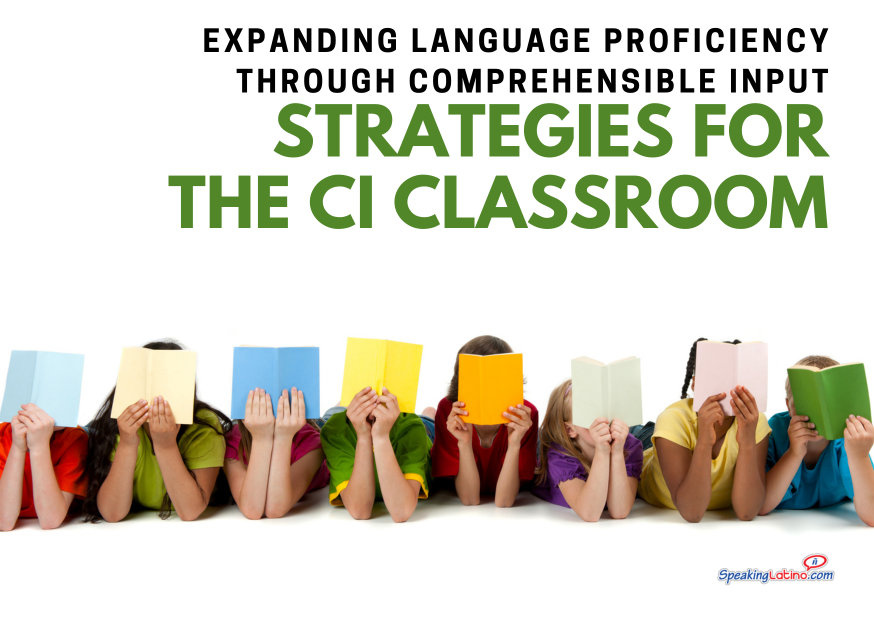
The content of this article is based on the presentation, CI Through Interpretive Reading … Then What? by Joshua Cabral, which was part of the World Language Teacher Summit.
The Linguistic Foundation of Comprehensible Input
The pursuit of language proficiency is uniquely human, integrating cognitive, social, and educational dynamics. Distinguished educators in the field of language acquisition have long debated the merits of various instructional methodologies. A consensus emerges around the concept of comprehensible input (CI) as pivotal to developing language competency. The essence of CI rests in its accessibility—learners encounter language they can process, their comprehension facilitating intuitive grasp of structure and vocabulary. The educational landscape now embraces innovative practices to harness the power of CI, transforming language classrooms into dynamic environments for linguistic discovery and growth.
The Role of the CI Classroom
The CI classroom is simultaneously a crucible and a sanctuary for linguistic exploration. The focal point is not the rote memorization of grammatical rules but an immersive experience where meaning-making is paramount. By prioritizing the understanding of language, educators act as architects of an environment where learners construct linguistic competence through interaction with rich, meaningful content. This shift from a granular focus on accuracy to a more holistic embrace of communication signifies a pedagogical renaissance in language education, celebrating the complexity and joy of language learning.
Understanding Proficiency: Beyond Language Knowledge
Proficiency transcends mere knowledge of a language’s mechanics, encapsulating what learners can authentically communicate. It is a functional philosophy that considers language as a tool for real-life interaction. Fostering proficiency necessitates emphasis on a variety of communicative modes: interpretive, presentational, and interpersonal. Each mode targets specific skillsets, shaping a well-rounded linguistic profile for students that mirrors the multifaceted nature of real-world communication.
Interpretive Comprehensible Input and the Role of Literature
CI finds a powerful ally in the realm of literature, where novels, short stories, and other written artifacts convey meaning through narrative and thematic depth. Engaging with literature provides a fertile ground for interpretive skills, often intertwining cultural nuances with linguistic content. Endorsing novels such as “La Novelle Fie” exemplifies the practice of embedding language in a cultural context, where students not only learn words and phrases but also gain insight into the cultural tapestry that informs language use.
Cultural Contextualization: Expanding the Story
To maximize the utility of literature in language learning, educators employ creative strategies to deepen the cultural context. Map talks elucidate the geographical backdrop of narratives, enriching the story’s setting and situating language within its authentic spatial dimensions. This geographic anchoring of language fosters a comprehensive understanding of how place and culture shape linguistic expression.
The RAFT Approach: Diversifying Output
Student engagement is further amplified through the innovative RAFT (Role, Audience, Form, Topic) approach. This technique diversifies writing tasks by assigning varied roles, audiences, forms, and topics, thereby cultivating a sense of purpose and audience awareness in language use. By mimicking authentic communicative scenarios, students are propelled to produce compelling output anchored in meaningful contexts.
Compelling Input and Output: Symbiotic Pillars of Language Learning
The synergy between compelling input and output carves pathways for language acquisition. Teachers are tasked with curating content that captivates student interest, ensuring a merger of comprehension with engagement—a confluence where language solidifies naturally in the learner’s mind. The delivery of information must be finely tuned to the student’s level, employing the “I plus 1” principle where language is just beyond the current level of proficiency, serving as an effective bridge to higher levels of understanding.

Connecting personal experiences to CI novel content stimulate language acquisition
Reevaluating Assessment: Shifting Paradigms
Traditional assessment paradigms often overemphasize accuracy and completion at the expense of genuine communicative competence. In the communicative CI classroom, a more nuanced evaluation of proficiency level takes center stage, weighing functional language use over mere correctness. Rubrics, aligned with proficiency levels, furnish educators with a tool for holistic assessment, capturing the essence of language performance across interpersonal, interpretive, and presentational spectrums.
Developing Assessment Strategies: Proficiency Rubrics
The use of a 4-point rubric aligned with proficiency and performance benchmarks provides clear, transparent criteria for student evaluation. By attaching these rubrics to conventional grading systems, educators foster a balance between the new paradigm of communicative competence and existing institutional expectations. The focus remains firmly on communicative effectiveness rather than the granular aspects of accurate language reproduction.
Teacher’s Impact: Facilitating Meaning and Comprehension
The teacher serves as the linchpin in the process of language acquisition, orchestrating the flow of comprehensible and compelling input. Instructional strategies must prioritize opportunities for students to derive meaning from language, thereby enabling them to navigate the linguistic landscape intuitively. As curators of content, teachers are responsible for ensuring that input resonates with learners, cultivating a naturalistic acquisition akin to first language development.
The Subconscious Nature of Acquisition: Input-Driven Learning
Language acquisition occurs beneath the threshold of conscious thought, taking root as learners engage with meaning-focused messages. The didactic reliance on repetition and memorization yields to a more organic approach, recognizing the subconscious as the bedrock of language learning. Teachers tap into this innate capability, employing CI-based methodologies to foster subconscious rule formation through consistent and targeted exposure to the language.
ACTFL Communication Modes and Performance Descriptors
Understanding and incorporating the American Council on the Teaching of Foreign Languages (ACTFL) communication modes and proficiency levels into the curriculum equips educators with a comprehensive framework for structuring CI experiences. The detailed performance descriptors guide teachers in customizing input, ensuring it corresponds with the learner’s “sweet spot,” thus optimizing retention and internalization.
The Significance of Stephen Krashen’s “I plus 1” Principle
The renowned linguist Stephen Krashen posits that language acquisition thrives on comprehensible input slightly beyond the learner’s current capabilities. This principle underpins effective language teaching, urging educators to calibrate content delivery to challenge yet support the learner’s progress. Language, as the currency of thought and communication, flows most effectively when it both reflects and extends the learner’s experiences and capabilities.
FAQs about Comprehensible Input
What are some examples of practical assessment strategies?
Some practical assessment strategies include using rubrics based on proficiency levels, categorizing assessments by modes such as interpersonal, interpretive, and presentational, and aligning assessment scores with letter grades in the classroom setting. The focus is on assessing students’ proficiency levels and their ability to understand and make meaning of language in different contexts .
What is the role of the teacher in a communicative CI classroom?
The role of the teacher in a communicative CI classroom involves providing compelling input and creating opportunities for students to engage with language in meaningful ways. Teachers guide students in understanding and making connections with the language through various activities and assessments aligned with proficiency levels and communication modes. They play a crucial role in facilitating language acquisition through comprehensible and compelling input.

Interactive reading sessions and engaging activities enhance understanding and language proficiency
What are some examples of how to effectively incorporate CI novels or short stories in the classroom for language acquisition?
Incorporating CI novels or short stories in the classroom for language acquisition can be done effectively through various strategies such as:
- Pre-reading activities: Engage students by introducing key vocabulary, discussing the cultural context of the story, and setting the stage for comprehension.
- Reading aloud: Read sections of the novel or story aloud to students, focusing on pronunciation, intonation, and comprehension.
- Comprehension checks: Pause during reading to ask questions, summarize key points, or discuss the plot to ensure understanding.
- Post-reading activities: Encourage students to discuss the story, analyze characters, themes, and settings, and make connections to their own experiences.
- Extension activities: Have students create projects, presentations, or skits based on the novel or story to deepen their understanding and language skills.
- Writing tasks: Assign writing tasks such as summaries, reflections, or creative responses to the story to practice language production and expression.
By incorporating these strategies, teachers can effectively use CI novels or short stories to enhance language acquisition and engage students in meaningful language learning experiences
Forging Pathways to Proficiency through CI
The educational philosophy embraced by those who champion comprehensible input as a cornerstone for language learning redefines classroom dynamics, placing the learner’s communicative proficiency at the forefront. By adopting materials that resonate with learners, utilizing methodologies that foster meaningful output, and implementing assessment tools that gauge communicative competence, educators unlock the full potential of their students. Language learning, thus, becomes an enriching journey filled with cultural insights, cognitive challenges, and authentic self-expression.By prioritizing comprehensible and compelling input within the CI classroom, educators bridge the gap between language acquisition theory and pragmatic classroom applications, shaping a generation of linguistically proficient, culturally sensitive, and intellectually curious individuals capable of navigating an increasingly complex and interconnected world.